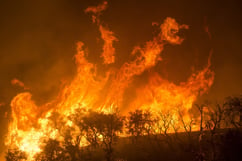
Summer is wildfire season in many areas, although its importance to your workplace obviously varies. We worry more here in California than folks in New England -- as I started this note my home region around San Francisco Bay had the worst air quality on the planet during a siege of wildfires from lightning strikes. If your workplace is a downtown high rise, wildfire risks are less than if it's in a suburban office park – and if you’re telecommuting during the COVID pandemic, it may depend less on your employer’s location than where you’ve set yourself up.
With these many variations in mind, the remainder of this note discusses how to assess wildfire hazards at your workplace, and basic steps to reduce those hazards. Response to actual fires requires different activities. For example, I wrote about workplace emergency action plans HERE and HERE, and employee protections from wildfire-induced hazardous air HERE.
What approaches might workplaces take?
Standard emergency preparedness approaches (including those noted in my early blog) involve assessing a location for possible hazards, and then designing and implementing steps to reduce and manage those risks. In considering wildfires, for example, workplaces can follow guidance from the Occupational Safety and Health Administration (OSHA):
-
Create an evacuation plan
-
Make a safety zone of at least 30 feet around the business
-
Consider an extended safety zone extending 100 feet
OSHA recommendation refers to guidance from the California Department of Forestry and Fire Protection (CAL FIRE) addressing larger zones – OSHA does not mention that California law requires 100 feet of “defensible space” around a “building or structure in, upon, or adjoining a mountainous area, forest-covered lands, brush-covered lands, grass-covered lands, or land that is covered with flammable material.” (Public Resources Code 4291). CAL FIRE’s guidance identifies the following measures:
-
Zone 1 (30 feet from buildings, structures, decks, etc.
-
-
Remove all dead plants, grass and weeds (vegetation).
-
Remove dead or dry leaves and pine needles from your yard, roof and rain gutters.
-
Remove branches that hang over your roof and keep dead branches 10 feet away from your chimney.
-
Trim trees regularly to keep branches a minimum of 10 feet from other trees.
-
Relocate wood piles to Zone 2.
-
Remove or prune flammable plants and shrubs near windows.
-
Remove vegetation and items that could catch fire from around and under decks.
-
Create a separation between trees, shrubs and items that could catch fire, such as patio furniture, wood piles, swing sets, etc.
-
-
Zone 2 (additional 70 feet, to a total of 100):
-
-
Cut or mow annual grass down to a maximum height of 4 inches.
-
Create horizontal space between shrubs and trees, twice the circumference of shrubs and 10 feet between trees.
-
Create vertical space between grass, shrubs and trees, of 3 times the height of the shrub.
-
Remove accumulated fallen leaves, needles, twigs, bark, cones, and small branches deeper than 3 inches.
-
Both agencies suggest that wider zones might be necessary in particular situations, and point out that paving or other hard surfaces are even less flammable.
Other CAL FIRE guidance documents include additional information. For example, CAL FIRE provides a “Homeowner’s Checklist” with the following items and additional sub-items:
-
Design/Construction -- i.e., of structures and additional lot improvements, emphasizing use of inflammable materials and spacing
-
Access -- i.e., to ensure escape for occupants and access for fire responders
-
Roof -- i.e., emphasizing use of inflammable materials]
-
Landscape -- including the 30 and 100 foot zones and plant spacing identified above
-
Yard - siting necessary items (e.g., LPG tanks) appropriately and minimizing accumulations of flammable materials
-
Emergency Water Supply
Most of these measures are appropriate to design, construction and operation at workplaces.
Now what?
Building owners and operators in California must comply with these requirements; state-level provisions from CAL FIRE are being supplemented by local ordinances assigning inspection and regulatory oversight to fire departments and districts. Other states have similar requirements, and employers and employees in non-regulated locations should also consider these items as hazard reduction measures. Readers whose residences are subject to similar hazards should also conduct hazard assessments and should consider – or may be required to undertake – some or all of the hazard-reduction measures identified above.
Self-evaluation checklist
Does the organization occupy structures, or distinct portions of structures, which are susceptible to wildfire hazards?
Are any of the organization’s facilities subject to state or local wildfire hazard assessment and management requirements?
If so, has the organization assessed these locations for site-specific wildfire hazards and fire safety measures?
If so, has the organization incorporated hazard reduction and fire safety measures into relevant structures and activities?
If so, does the organization include assessment of wildfire hazards and fire safety measures in the design and construction of new facilities, and selection criteria for selecting facilities to be rented or leased?
Where can I go for more information?
About the Author
 Jon Elliott is President of Touchstone Environmental and has been a major contributor to STP’s product range for over 30 years.
Jon Elliott is President of Touchstone Environmental and has been a major contributor to STP’s product range for over 30 years.
Mr. Elliott has a diverse educational background. In addition to his Juris Doctor (University of California, Boalt Hall School of Law, 1981), he holds a Master of Public Policy (Goldman School of Public Policy [GSPP], UC Berkeley, 1980), and a Bachelor of Science in Mechanical Engineering (Princeton University, 1977).
Mr. Elliott is active in professional and community organizations. In addition, he is a past chairman of the Board of Directors of the GSPP Alumni Association, and past member of the Executive Committee of the State Bar of California's Environmental Law Section (including past chair of its Legislative Committee).
You may contact Mr. Elliott directly at: tei@ix.netcom.com

